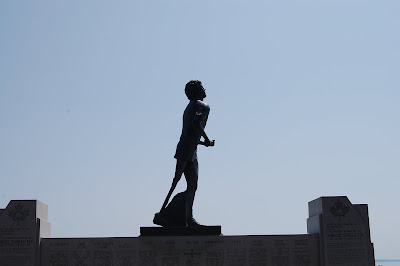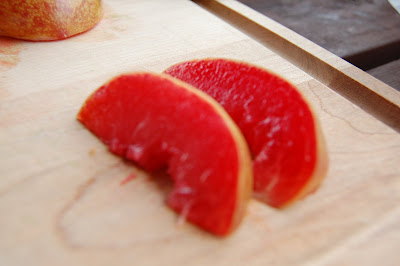
After the most recent farm experience, checking into a city was a pretty unexpected change. Saskatoon is the largest city in Saskatchewan, it's only real competition being Regina. We had a really unexpectedly good experience here. The city is quite beautiful, boasting some quite decent character, and, luckily for us, mostly great weather. As a side note, I'm about to make cheese in real time, not blog time, so stay tuned for that as the story unfolds. I've run far behind here, and am hoping to do some power blogging ASAP. You'll know when it happens. Regardless, back to Saskatoon.
Having done little to no research on the area, we were relatively bent on getting to a canola oil producer and seeing that, but had no other real aim in mind. After a mediocre farmers market with only one thing bearing mention, a booth run by heat addicted, greenhouse owning psychopath, we were pretty miffed with the food scene.

The peppers we bought from him were of the highest quality though, including that hottest pepper in the world, which we mixed into some spicy bannock, apricot chutney and other things. It is called a naga, and skin contact results in blisters. It is 21x hotter than a Habanero, do not mess with me, I have a naga. We also procured some chipotle and a habanero, both of really high quality and freshness. Using the naga is like working with mouth dynamite that might blow your head off at any moment. We resorted to slicing fine slices off, chopping them intensly, then introducing the appropriate amount to our food. It worked, no open sores at all. Not even a skin blister. And now that it is safely packed in a basil and chili oil concoction, no more danger. We decided that beer was on the menu for this evenings dinner, and crossed the street to Cava,

Saskatoon's most exclusive wine and beer store. The store is pretty impressive, though it could be viewed as pretentious, our aide was extremely laid back and helpful. We got an unfiltered french wheat beer from Quebec. Les Trois Mousquetieres. We then cooked up a storm at the local campus and coasted out the rest of the night there. It was laid back.
The next day we did a bit of exploring. At the recommendation of the tourist information booth, we visited a bistro/deli/grocery thing that I don't know how to describe as anything else than it's name, Souleio. Souleio is the brainchild of a threesome of people based in and around Saskatoon, all doing good things with food. The farm connection is Kevin Boldt, who not only raises his own animals, but has a processing facility for others as well. He sells largely to Saskatoon, and provides both Souleio and Calories restaurant with their meat. Calories restaurant is the second connection, where chef Remi Cousyn and his wife run a restaurant bent on using local produce and establishing great relationships with producers. Out of his great relationship with producers Pineview farms, which is Kevin Boldts enterprise, came Souleio. The third connection is the people who are the foot soldiers for Souleio, Edyta and Uwe. Edyta was our consummate host and the first of this crew we got into contact with. After going into the deli/bistro/grocery just to observe, and seeing not only great products, but also products produced by people we had already visited, we needed to speak to whomever was doing the ordering. Hence, Edyta. She was delightful company the whole way through, and even went the extra mile, inviting us to visit a Hutterite colony from which they receive a fair amount of produce, both at Souleio and Calories. That will get it's own post, as it was an adventure in reality vs. perception that I won't soon forget, among other things. After we set up a lunch meeting with Edyta, she was kind enough to sit and talk with us a little while, and even introduced us to her Chef, Uwe, who brought out an excellent charcuterie plate, including a speciality of his home area in Germany. He also gave us a beer that is almost worthy of it's own post. We talked some more about their business, future prospects, and the local scene, before promising to meet again early Monday to join the convoy to the Hutterites. It had already been an awesome experience, and the fun was just beginning. Saskatoon was turning out great.
We had contacted the University of Saskatoon after visiting their campus earlier to eat somewhere. They have a massive and impressive array of greenhouses, which we were determined to tour. They let us. We met with Jackie, the greenhouse operator and overseer, to check what was going on. She not only gave us a rip around in the greenhouse facilities, which are epic, but also their agricultural territories, equally monstrous and perhaps more impressive. The greenhouses house largely cash crops, or pulse crops, so lots of corn varietals, lentils, chickpeas and barley. This is where the genetic modification goes on and varietals are bred at exceedingly fast speeds to favour a certain trait. It's a feat of great wildness, and the students have projects ranging from hydrangias to grapes. Thats right, grapes. Some awesome wacko is trying to breed pinot noir with a local strain of grapes in order to be able to grow grapes in the region. Apparently its working very well, and he intends to try wines relatively soon. Another amazing project is prairie lemons. A professor is working this one. He brought in lemons and limes from the climate he deemed the most similar to Saskatoon's, and is breeding them to be hardier fruiting trees, hoping eventually to have prairie citrus. Mind boggling stuff. On the tour of the grounds, we saw many different cherries, a load of Saskatoon berries, asparagus gone wild, lettuce gone wild, and whole wack of other things that fused particular areas of my brain shut, disallowing me from accessing the memories. Or maybe I'm just sworn to silence. Hopefully the latter. I have never seen anything more surprising than the asparagus. When it doesn't get picked, that plant gets crazy.

Indescribably so, like a green cloud with hints of fennel. The lettuces were almost more surprising. Most of them were well tended to, but apparently a single student had decided to let his grow to the fullest extent possible. It turns out that the full extent is extremely full. It was a lettuce monster. Terrorizing other salad greens the world over. Probably standing around 4 feet tall with a stalk nearly the size of my waist. I was suitably impressed. We visited the Saturday market just to see what could be seen, as we had been told it far outstrips the Thursday market. That was true in the extreme. More producers, more variety, much more interesting products, and a more engaged crowd. We bought a few tidbits for dinner and decided we were in the agrarian mood.

We decided that visiting Pineview farms to see where the meats come from would be a good way to not only see what the buzz was about, but also meet some of the people we would be traveling with the next day. Kevin was kind enough to take us on a quick tour of both his slaughter facility and farm. The facility is really impressive, quite a bit more mechanized than rocking out the down home way in the Yukon, but we'll forgive that, because he does more than 10x as many birds, and no restrictions to chicken. The facility can also go geese, ducks, turkey, and rabbit. He has a wicked vegetable garden as well, and some tasty carrots. We were just about to leave when he decided that being vegetarian wasn't appropriate for us two large lads, and threw a pork loin at us. It was stellar. We cooked in the nearby town of Osler, with baby artichokes we nabbed at the market for pure interest sake. The artichokes were sadly disappointing, chewy and obnoxious. I think a butter poach would be more appropriate. They were definitely aesthetically pleasing. After eating we returned to Saskatoon, and bunked down nearby the farmer's market.

We were apparently visiting the past the next day, so I figured sleep would be good, having to deal with a bunch of religious junkies, hopped up on their farmed goods and god. I have never been more wrong than about these people. It was an eye-opener.



















































